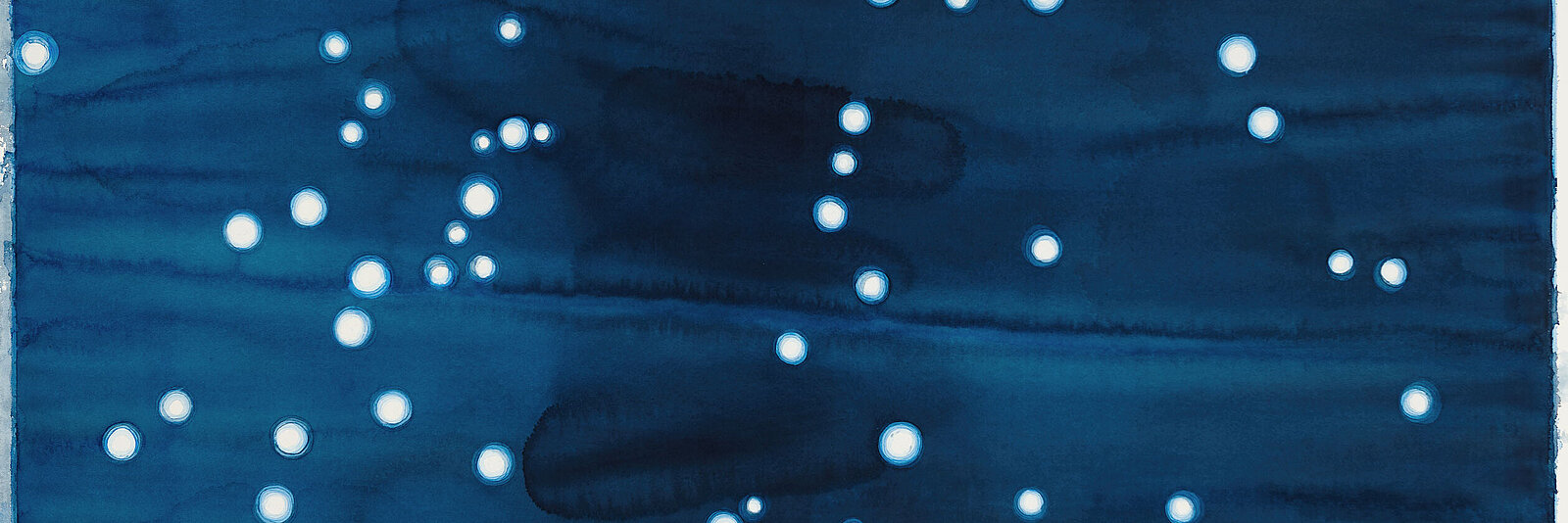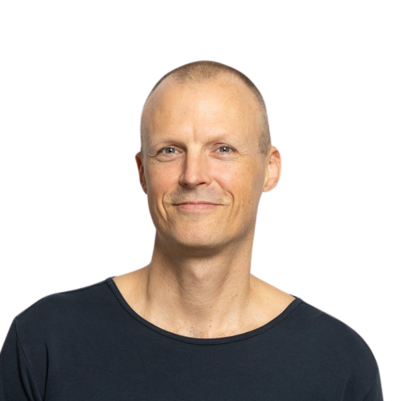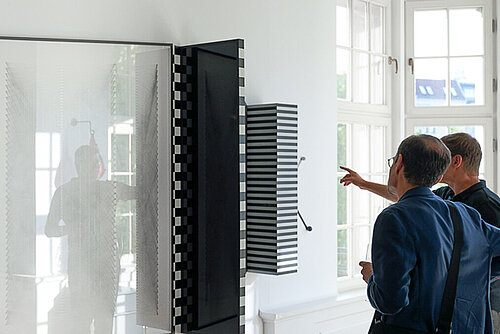
How do we remember images - and if so, how many?
Gradual traces of coloured pencil and watercolour: sharp and blurred layers of memory in Sławomir Elsner's work
Berlin-based artist Sławomir Elsner uses coloured pencil drawings, watercolours and sculptures to create spaces of memory with very different art-historical references. In the run-up to his exhibition in our offices*, we visited him for a chat about art and layers of memory.
Undconsorten: Dear Sławomir, thank you for allowing us to visit you in your studio. This space right next to the famous Kantgarage used to be a club synagogue - how does that speak to you and your work?
Sławomir Elsner: When I first visited the site, I immediately realised that I wanted to work here. Its history is exciting and full of ruptures - all the traces are still visible today. At the same time, the location and size are ideal for me - I always wanted to live and work in Berlin, as a centre between East and West and as a focal point for many cultures.
&co: How do your works relate to the idea of memory and history?
SE: I often play with such references and layers of memory in my work. I am also concerned with the question: How do we see images? Especially when it comes to certain icons of art history, but also in general. How do we remember this painting when we leave the museum? Will I then only have it as a postcard or as a mobile phone photo?
&co: To what extent are your works actually works of art in their own right?
SE: The art historianAnne-Marie Bonnet wrote about my approach: "What do I actually do with art historical images? I don't copy them, I don't interpret them - I evoke them." I thought that was actually very apt.

&co: Anne-Marie Bonnet also speaks of a "general uncertainty" in the "understanding of reality and truth" in the context of current developments in politics and digital media. To what extent are remembering and realising history in your artworks also a game of cognitive distortion and prejudice?
SE: For me, iconic works such as Rembrandt's portraits or van Gogh's sunflowers are starting points for playing with memory. My own works are very open, the interpretation is up to the viewer. They can compare my work with the original - or receive it as an independent contemporary image. The decision is up to them.
&co: Do you also see your art as a way of remembering beyond formal art - perhaps in a political or social context?
SE: Yes, definitely. I see my art as a form of remembrance that goes beyond the purely aesthetic aspect. Political or social contexts can also resonate through the choice of certain themes and motifs. I recall past events or make connections to social developments that are often not directly addressed, but are nevertheless reflected in the art.
&co: Your works repeatedly thematise historical layers and the repressed. To what extent has your own family history - travelling between Poland and Germany - influenced your artistic approach?

SE: That certainly plays a role. My grandfather was born in Silesia near Katowice - still in Prussia at the time. After the First World War, it became Polish territory, just over the border. In 1939, when Germany invaded Poland, he was drafted into the army as a Polish citizen. Two years later: a German prisoner of war. Suddenly he was told: "You can speak German? Then fight for the Wehrmacht now." Towards the end of the war, he joined the resistance army of Polish General Władysław Anders. He was allowed to return home straight after the end of the war - his brother, also in the Wehrmacht, ended up in Siberian captivity. When we came to Germany as ethnic German repatriates in 1987, the state initially refused to grant my father German citizenship. The reason? His father had "betrayed the Wehrmacht". These overlapping identities - German/Polish, perpetrator/victim, loyalty/betrayal - possibly create a basic tension in my art. Working with different overlapping layers is not about mere decoration. It is perhaps more a game of hide and seek.
&co: You are particularly well known for your works with coloured pencils. Is this a widespread technique and how did you develop it for yourself?

SE: During my studies in Kassel, I tried to acquire as broad a knowledge base as possible and visited all the available workshops there. It was very important to me to understand different options and forms of expression. That's also how I came to drawing through a drawing teacher and then developed my own style over time.
&co: Control over the medium is present in your coloured pencil works. What role does the element of "chance" play in your work with watercolours, keyword frustration tolerance - and is your switching between techniques also a game between the themes of excellence and pragmatism?
SE: Chance certainly plays a role in the subconscious. It often produces results that I can't foresee - but it also allows me to pick up creative impulses that I then develop further. Chance has a kind of "magic" that encourages me to further scrutinise and shape the picture. I try to use it to gain new perspectives and impressions, even if I have a clear goal for the picture.
&co: How do you deal with mistakes and unexpected results in your work? Do these mistakes have a creative value for you?
SE: Sometimes there is a mistake, and this watercolour technique is not forgiving of these mistakes - and then it's broken. For example, if I get a line in a place where I don't want it due to drying effects - then I sort the sheet out. I'm then critical and don't allow these mistakes to happen.

Sometimes it's enough for a fly to sit on the damp paper - that's why I have curtains in front of the front door (laughs).
&co: So you usually have a clear picture of what you want to achieve.
SE: Yes, but then there are motifs where I have a clear image and there happen to be different layers that develop in an uncontrolled way due to the nature of the paper and humidity. I then allow that to happen.
&co: Are there also cases where you come up with unexpected results by accident, so to speak?
SE: Yes, when an unexpected effect occurs, such as crystal-like drying structures, I sometimes even try to reinforce these discoveries, for example by using even more water. So a certain openness is definitely part of the creative process.
&co: How would you describe your approach to watercolour painting and how does it differ from other painting techniques?
SE: During my studies with Norbert Radermacher, I had the idea that I didn't want to use watercolour painting simply to colour surfaces, but as an independent and holistic medium. That didn't really exist back then.

I work very gradually, with many thin layers of colour on top of each other, which requires a slow but very controlled technique. While other painting techniques are based more on direct, bold applications, I appreciate the transparency and play of colours created by the water in watercolours. This means that the painting remains very much alive and in constant development during the painting process, which allows me to work with unexpected results and integrate them into my artwork.
&co: What is behind this technique and why do you use it?
SE: The many layers in my watercolours create depth, sometimes also darkness and a certain blurriness, which is what makes the technique so appealing to me. It's almost like a slow unfolding of the colours.
&co: That sounds very time-consuming - how much time does this technique take?
SE: It depends a bit on the quality of the paper and how much water I use. If I'm lucky, I can do two layers of colour a day. That's why I can combine this technique well with the coloured pencil drawings: When I come to the studio in the morning, I first apply the new layers and then draw while they dry.
&co: You often depict the same motif several times in different ways. Does working in series generally seem very important to you?
SE: Not really, for me the series means that I do several works on one subject. However, within the Imaginary Memory series, for example, a work based on Ruben's Honeysuckle Bower, I have then processed a motif 17 times, paraphrased it.

Or as you can see here: van Gogh's sunflowers are also paraphrased in two different versions in watercolour. For example, if I use very little water in my watercolours, the result is very close to the picture I had in mind. If, on the other hand, I use a lot of water, the pigment separates from the binder and runs off unpredictably. The result is then even more alienated from the original. In extreme cases, the layers mix so much that in the end there is only one colour. The memory is then completely blurred or obscured, virtually made impossible - or only possible again through the context of the series.
&co: How long did it take you to create the 17 works in their original size for Imaginary Memory ?
SE: I worked on it for a total of three years.
&co: Wow! How close does that bring you to the edge of madness?
SE: (Laughs) At some point I tried to take a step back with the watercolours.
&co: You have used gold as an additional element in some of your works. What does it mean to you to integrate gold into your watercolour technique?
SE: First of all, gold is very delicate in watercolour painting because every time I use gold, the underlying gold pigments - and therefore the previous layer - dissolve with it. The new layer covers the motif like an impenetrable veil or film. This creates the feeling that what is behind it becomes less concrete or important. I find it exciting that this is more about sensing and therefore perhaps about a more tactile and attentive perception.
&co: Sometimes it goes so far that you even ask yourself whether a specific motif is visible at all - or whether you simply overlook it.
SE: Especially when using metal pigment, including silver, it happens that the finished work reflects from many sides in such a way that you can never capture the entire motif. Depending on your point of view, different partial aspects always emerge.
&co: Have you ever combined both techniques, coloured pencils and watercolour?
SE: Yes, I've done that too, for example in a series of works from 2011-12 that dealt with the refugee situation at the time. Last year, I also worked in this way on a piece that was basically a visualisation of a glitch, a failed print. I'm also currently working on something completely new. For example, I'm doing small tests with motifs from a film, quasi film stills with the look of a broken Polaroid.
&co: In the past, you have made economic and creative decisions that you felt were necessary. How much has the art market influenced your decisions as an artist, and how do you see the art scene in terms of the success and consumability of artists in today's economic environment?

SE: The art market has certainly influenced my decisions, but I try not to let it guide me too much. I have always tried to stay true to my artistic integrity and not produce my work for commercial reasons. When I'm finished with a series of works, I move on to new things, even if the works have sold very well and a gallery owner might want to sell more of them. I actually lost a gallery that way once (laughs). The art scene today has become much more global and commercial in terms of the success and accessibility of artists. Success depends not only on the quality of the art, but also on the right networking and the ability to assert oneself in this highly competitive market. Nevertheless, it is important that artists are not only guided by market conditions, but also have the independence to work creatively and break new ground.
&co: Exciting, there are also moments like that in counselling. For example, when we have to contradict a client because we are not convinced of a wish or a directional decision.
SE: As an artist, I sometimes have an intrinsic urge for freedom that sometimes makes me work contrary to market mechanisms in the short term. However, even these works do sell in the long term, which is always a question of economic cycles. This sometimes perhaps somewhat naive attitude towards demand is important in order to be able to develop as an artist and be happy with what you do.
&co: During the production of the individual works and series, do you already think about the arrangement in an exhibition? How do you approach the hanging in our office, for example?
SE: I have to look at the rooms several times beforehand. In your case, the situation is special in that you have already exhibited many works by different artists. That's why I came up with the idea of taking my works from different work phases so that a visitor to your rooms doesn't immediately recognise that it's a (homogeneous) exhibition by one artist.

&co: That fits in very well, you fit in and challenge us to take a closer look and scrutinise things. We are already very much looking forward to this exciting inspiration in our workspaces.
Dear Sławomir, thank you very much for the interview!





